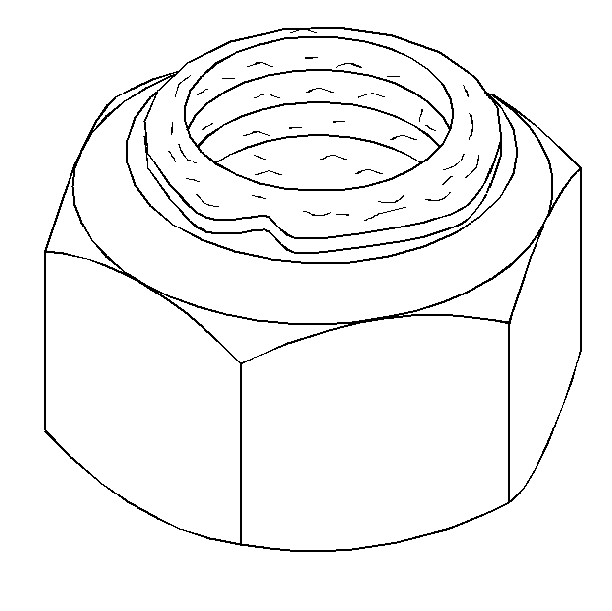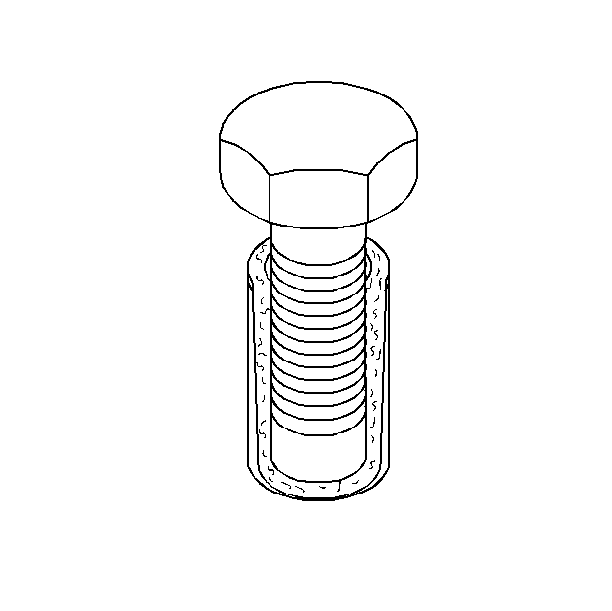Metric Fasteners
Current model GM vehicles are primarily dimensioned in the metric system.
Many of the fasteners used on GM vehicles are metric, but are very close in
dimension to well-known inch system fasteners. Use replacement fasteners which
match the original equipment fasteners in the following ways:
Original equipment metric fasteners (except "beauty" bolts,
like exposed bumper bolts and cross-recess head screws) are identified by
a marking or a number which indicates the strength of the material in the
fastener.
Metric cross-recess screws are identified as either Posidriv or Type
1A. Either Posidriv or Type 1A cross-recess screwdrivers can used in Posidriv
recess screw heads. However, Type 1A cross-recess screwdrivers perform better.
Prevailing Torque Fasteners
A prevailing torque nut creates interference between the nut threads
and the bolt threads. A nylon patch on the threads in the middle of the hex
flat achieves interference. Interference secures the nut against loosening.

A prevailing torque bolt creates interference at any of the following
fastening points:
| • | Between the threads of the prevailing torque bolt and the threads
of the bolt |
| • | Between the threads of the prevailing torque bolt and the threads
of a tapped hole |
The prevailing torque bolt achieves interference in the following ways:
| • | By permitting distortion of some of its threads during fastening |

| • | By imbedding a nylon patch or nylon adhesive
into the bolt threads or the hole threads during fastening |
Interference secures the bolt against loosening
Recommendations For Reuse
Observe the following guidelines for reusing prevailing torque nuts
and bolts:
| • | Replace any rusty or damaged prevailing torque fasteners. |
| • | Discard the old fasteners. |
| • | Follow these steps in order to prepare clean, non-rusted prevailing
torque fasteners for reuse: |
| 1. | Clean dirt and other foreign material off the nut or the bolt. |
| 2. | Inspect the nut or the bolt for cracks, elongation or other signs
of overtightening. If the fastener appears questionable, discard the fastener. |
| 3. | Starting the fastener by hand, begin the assembly procedure. If
the fastener does not achieve the proper torque before seating, discard the
fastener. |
| 4. | Tighten the fastener to the torque specified by the assembly procedure. |
Fastener Strength Identification
Metric nuts and bolts are divided into metric fastener strength property
classes. The most common metric strength property classes are 9.8 and 10.9.
Class identification is embossed on the head of each bolt. Some metric nuts
are marked with single digit strength numbers on the nut face.
Replace a metric fastener with a fastener of equal or greater strength.
The strength identification number on a replacement fastener should be the
same as, or higher than, the strength identification number on the original
fastener.
Replace torque-to-yield fasteners with identical fasteners using GM
SPO part numbers.
The metric fasteners used on GM products are designed to international
standards. Some non-domestic nut and bolt suppliers may not observe these
standards. Non-domestic fasteners may not meet GM requirements for the following
reasons:
| • | Non-domestic fasteners may not display the numbered head marking
system. |
| • | Non-domestic fasteners may be weaker than domestic fasteners. |
| • | Non-domestic fasteners may have a different thread pitch. |
Metric Fasteners
This vehicle provides fastener dimensions using the metric system. Most metric
fasteners are approximate in diameter to equivalent English fasteners. Make replacements
using fasteners of the same nominal diameter, thread pitch, and strength.
A number marking identifies the OE metric fasteners except cross-recess head
screws. The number also indicates the strength of the fastener material. A Posidrive®
or Type 1A cross-recess identifies a metric cross-recess screw. For best results,
use a Type 1A cross-recess screwdriver, or equivalent, in Posidrive® recess
head screws.
GM Engineering Standards and North American Industries have adopted a portion
of the ISO-defined standard metric fastener sizes. The purpose was to reduce the number
of fastener sizes used while retaining the best thread qualities in each thread size.
For example, the metric M6.0 X 1 screw, with nearly the same diameter
and 25.4 threads per inch replaced the English 1/4-20 and 1/4-28
screws. The thread pitch is midway between the English coarse and fine thread pitches.
Fastener Strength Identification




